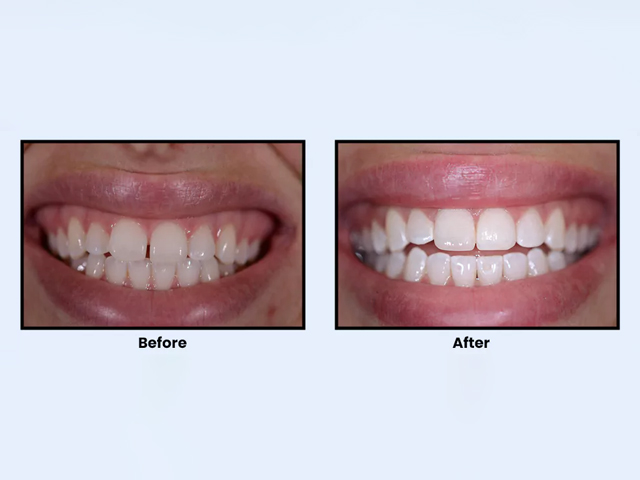
When teeth are not in the correct position in the arch, the least invasive and best way to correct the mispositioned teeth is to move them with orthodontics. However, many times the teeth are worn and lack the normal length and may be worn unevenly. When we put the teeth in their normal position, they may not have an aesthetic appearance.
An orthodontist who is moving worn teeth has trouble envisioning the correct position of the tooth due to the missing tooth structure. Additionally, at the end of orthodontic treatment, there may not be enough room for the final restorations, and additional procedures may be needed adding cost and time to the final desired outcome.
Transitional bonding is the answer. The dentist uses composite, a white-colored filling material, to restore the normal length and shape of the teeth. This can be done either prior to orthodontic treatment or partway through the orthodontics.
Transitional bonding can also take place in the middle of orthodontics in cases of severe crowding or when a lot of tooth structure is missing. It is easier to move the teeth and make some space, then remove the brackets or buttons and reshape the teeth with composite. The brackets or buttons are then replaced, and the final orthodontic tooth movements are performed.
In the process of transitional bonding,the teeth are measured, and a plan is made for the desired length and shape of the teeth. Models of the teeth made the desired length and shape of the teeth are designed by adding wax to the model and carving the teeth into the desired shape. This wax shape is then transferred to the mouth using a solid putty stent. The dentist then bonds tooth-colored composite and shapes and polishes the teeth.
Sometimes after transitional bonding, the teeth will not fit together properly. To correct this bite blocks are placed on the back teeth to protect the bonding while the orthodontist moves the teeth. It is important that the orthodontist and dentist have a good understanding of the desired goals and the timing of the transitional bonding.
At the end of treatment, there are 3 choices:
- Keep the transitional bonding without any changes if it aesthetically looks good to the patient.
- Upgrade the transitional bonding by adding color and translucency with composite.
- Replace the transitional bonding with ceramic veneers or crowns.
Another benefit of transitional bonding is that complex treatment can be phased over time for financial or timing concerns.
If you have esthetic concerns, the most important starting place is to have a comprehensive aesthetic evaluation by a dentist trained in cosmetic treatment planning. Dr. Saydyk has trained extensively with Spear Education, the American Academy of Cosmetic Dentistry, Phalen Seminars, Marshall Hanson Cosmetic Dentistry, and many others. Our office focuses on treating complex cosmetic and functional cases. Please contact our office to set up your evaluation today.

